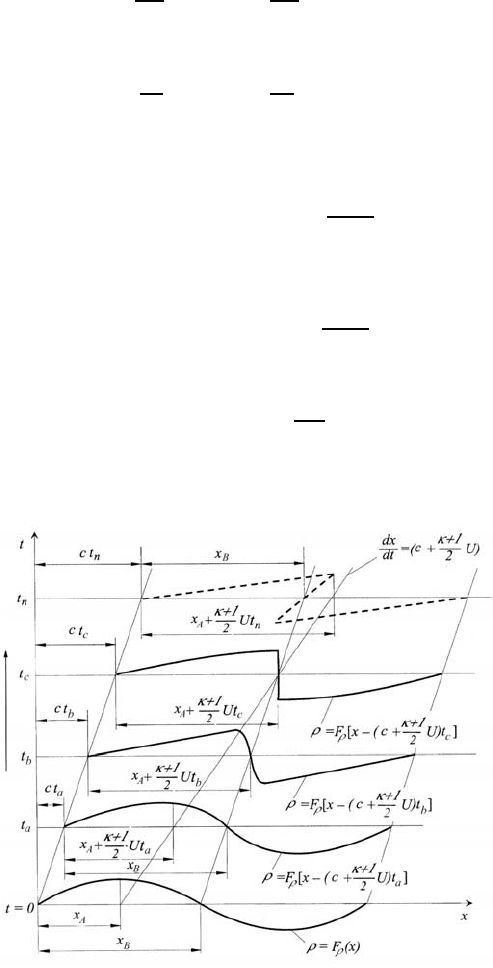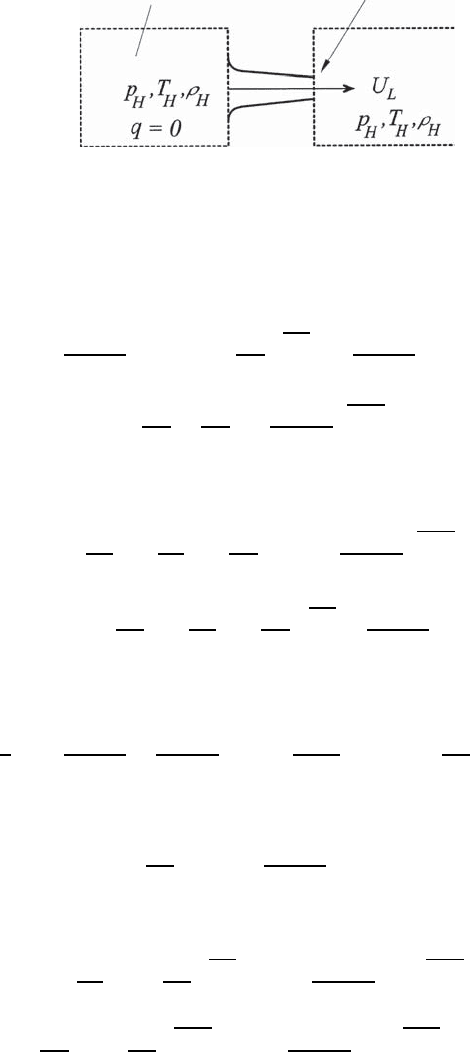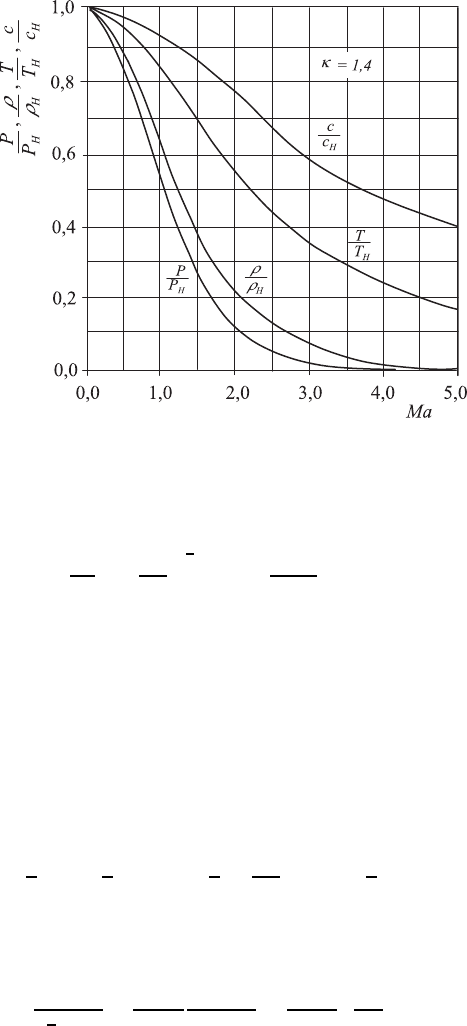Durst F. Fluid Mechanics: An Introduction to the Theory of Fluid Flows
Подождите немного. Документ загружается.


12.3 Non-Linear Wave Propagation 339
Momentum equation:
∂U
∂t
+ U
∂U
∂x
= −
1
ρ
∂P
∂x
. (12.26)
From (12.25) the following relation results for ρ = ρ(U):
dρ
dU
∂U
∂t
+ U
dρ
dU
∂U
∂x
+ ρ
∂U
∂x
=0. (12.27)
Analogously, (12.26) can be written:
∂U
∂t
+ U
∂U
∂x
+
1
ρ
dP
dρ
dρ
dU
∂U
∂x
=0. (12.28)
On multiplying (12.28) by dρ/dU and subtracting it from (12.27), one
obtains:
ρ
∂U
∂x
=
1
ρ
dP
dρ
dρ
dU
2
∂U
∂x
, (12.29)
or rewriting:
dU
dρ
= ±
1
ρ
$
dP
dρ
= ±
1
ρ
$
∂P
∂ρ
ad
. (12.30)
This equation can now be integrated:
U
#
0
dU = ±
ρ
#
ρ
∞
$
dP
dρ
dρ
ρ
. (12.31)
For isentropic flows, i.e. P/ρ
κ
= constant, (12.31) can be integrated:
U = ±
ρ
#
ρ
∞
√
κ constant ρ
κ−1
2
dρ
ρ
= ±
2
κ − 1
κρ
κ−1
constant
ρ
ρ
∞
U = ±
2
(κ − 1)
(a − c). (12.32)
Thus for the propagation velocity of a wave of large amplitude:
a = c ±
(κ − 1)
2
U, (12.33)
a propagation velocity a results, which depends on the local flow velocity.
Here c is the computed sound velocity for the undisturbed fluid.
By inserting (12.30) into (12.28), one obtains the following relationship:
∂U
∂t
+ U
∂U
∂x
±
$
dP
dρ
∂U
∂x
=0, (12.34)

340 12 Introduction to Gas Dynamics
or rewritten:
∂U
∂t
+(U ± a)
∂U
∂x
=0. (12.35)
From the continuity equation, one obtains:
∂ρ
∂t
+(U ± a)
∂ρ
∂x
=0, (12.36)
so that for ρ the following general solution of the differential (12.36) can be
stated:
ρ = F
ρ
(x
1
− (U
1
± a)) = F
ρ
x
1
−
c ±
κ +1
2
U
1
t
, (12.37)
where F
ρ
() can be any function. Analogously for the velocity:
U = F
u
(x − (U ± a)) = F
u
x −
c ±
κ +1
2
U
t
. (12.38)
Equations (12.37) and (12.38) allow one to explain the propagation of a
disturbance with a propagation velocity c ±
κ+1
2
U. Because of this propaga-
tion velocity, which depends on the local flow velocity, wave deformations
develop as they are indicated in Fig. 12.8. On considering the propagating
Progress in time
Fig. 12.8 Wave deformations and formation of compression shocks

12.4 Alternative Forms of the Bernoulli Equation 341
part with a + sign, then characteristic position changes in times t can be
stated as
x
A
= c · t
ω
; x
B
= x
A
+ ct
a
+
κ +1
2
Ut
a
; x
C
= x
B
+ ct
b
. (12.39)
The developing and progressive deformation of the wave is apparent. Thus
the formation of compression shocks comes about.
The local ambiguity of the density stated in Fig. 12.8 for t
n
cannot occur,
of course. When the wave front has built up in such a way that all thermody-
namic quantities of the fluid and also the velocity experience sudden changes,
then the maximum deformation possible of the propagating flow is reached.
A compression shock has built up.
12.4 Alternative Forms of the Bernoulli Equation
In Sect. 9.4.2, the stream tube theory was used to consider one-dimensional
isentropic flows leading to the Bernoulli equation for compressible flows:
1
2
U
2
+
κ
(κ − 1)
P
ρ
=
κ
(κ − 1)
P
H
ρ
H
. (12.40)
The thermodynamically possible maximum velocity was determined for
(P/ρ) → 0:
(U
max
)
2
=
2κ
(κ − 1)
P
H
ρ
H
=
2κ
(κ − 1)
RT
H
. (12.41)
Thus (12.40) may be expressed as
1
2
U
2
=
1
2
U
2
max
−
κ
(κ − 1)
P
ρ
. (12.42)
As the Mach number represents a fundamental quantity in the treatment of
gas-dynamic flow problems, we can write
1=
U
max
U
2
−
2κ
(κ − 1)
RT
U
2
=
U
max
U
2
−
2
(κ − 1)
1
Ma
2
. (12.43)
or rewritten:
1
Ma
2
=
κ − 1
2
3
U
max
U
1
2
− 1
4
. (12.44)
The basis for the above considerations was an expanding flow, as it is in-
dicated in Fig. 12.9. For this flow the so-called critical state results, when
the local velocity reaches the speed of sound, i.e. U
1
= c = U
c
. Then, from
(12.40):
1
2
U
2
c
+
U
2
c
(κ − 1)
=
c
2
H
(κ − 1)
U
2
c
=
2κ
(κ +1)
RT
H
. (12.45)

342 12 Introduction to Gas Dynamics
Large reservoir
Nozzle end
x = L
1
x = 0
1
Fig. 12.9 Flow between two pressure tanks of different pressures
The critical pressure can be computed according to (12.40), considering
(12.45) and assuming isentropy:
U
2
c
=
2κ
(κ − 1)
RT
H
3
1 −
P
c
P
H
κ−1
κ
4
=
2κ
(κ +1)
RT
H
. (12.46)
P
c
P
H
=
P
∗
P
H
=
2
(κ +1)
κ
(κ−1)
. (12.47)
Employing the relationships for isentropic density and temperature changes,
one obtains:
ρ
c
ρ
H
=
ρ
∗
ρ
H
=
P
∗
P
H
1/κ
=
2
(κ +1)
1
(κ−1)
. (12.48)
T
c
T
H
=
T
∗
T
H
=
P
∗
P
H
κ−1
κ
=
2
(κ +1)
. (12.49)
The above results may now be expressed in terms of the Mach number. From
Bernoulli’s equation for compressible fluids it follows that:
1
2
U
2
1
+
c
2
(κ − 1)
=
c
2
H
(κ − 1)
;
κ − 1
2
Ma
2
+1=
T
H
T
, (12.50)
or rewritten for the temperature ratio:
T
T
H
=
1+
(κ − 1)
2
Ma
2
−1
. (12.51)
For the density and pressure variations, the following relations can be
derived:
ρ
ρ
H
=
T
T
H
1
κ−1
=
1+
(κ − 1)
2
Ma
2
−1
(κ−1)
, (12.52)
P
P
H
=
T
T
H
κ
(κ−1)
=
1+
(κ − 1)
2
Ma
2
−κ
(κ−1)
, (12.53)

12.4 Alternative Forms of the Bernoulli Equation 343
Fig. 12.10 Diagram representing the parameter variations in the Bernoulli equation
For the sound velocity relation c/c
H
, the following results:
c
c
H
=
T
T
H
1
2
=
1+
κ − 1
2
Ma
2
−2
. (12.54)
The above relationships can be plotted as shown in Fig. 12.10. Thus, as
a result of the Bernoulli equation for isentropic flows, the figure shows the
change of pressure, density, temperature and speed of sound, each normal-
ized with its stagnation value. All data are represented as functions of Mach
number changes. This figure corresponds to Fig. 9.10 in Chap. 9, where the
temperature, density and pressure variations with (U
1
/U
max
) were employed
as a parameter for the representation of different forms of the Bernoulli
equation.
It is characteristic for compressible flows that the local dynamic pressure
1
2
ρU
2
1
=
1
2
ρc
2
Ma
2
=
1
2
ρ
κP
ρ
Ma
2
=
1
2
κP Ma
2
(12.55)
depends on the local pressure and the local Mach number.
For the normalized pressure difference, the following holds:
P
H
− P
1
2
ρU
2
1
=
2
κMa
2
P
H
− P
P
=
2
κMa
2
P
H
P
− 1
, (12.56)

344 12 Introduction to Gas Dynamics
and with (P
H
/P ) from (12.53) one obtains:
P
H
− P
1
2
ρU
2
1
=
2
κMa
2
3
1+
κ − 1
2
Ma
2
κ
(κ−1)
− 1
4
. (12.57)
Through a series expansion for Ma
2
<
2
(κ−1)
, the following results:
C
p
=
P
H
− P
1
2
ρU
2
1
=1+
1
4
Ma
2
+
2 − κ
24
Ma
4
+
(2 − κ)(3 − 2κ)
192
Ma
6
+··· . (12.58)
For incompressible flows, the Mach number goes to zero so that only the first
term of the series expansion remains. For compressible flows, with increasing
Mach number a substantial deviation of C
p
from the incompressible result is
obtained. However, for Mach numbers below 0.3. this deviation is below 1%.
Therefore, compressibility effects may be neglected up to this Mach number.
This is the basis for treating low-velocity gas flows as incompressible.
12.5 Flow with Heat Transfer (Pipe Flow)
Each chapter in this book tries to give an introduction into a sub-domain
of fluid mechanics and in particular each chapter aims at a deepening of
the physical understanding of the fluid flows treated there. For this purpose,
often simplifications were introduced into the considerations of an analyt-
ical problem. In the preceding chapter, for example, adiabatic, reversible
(dissipation-free) and one-dimensional fluid flows were treated, i.e. isentropic
flow processes of compressible media which depend on only one space coor-
dinate. These considerations need some supplementary explanation in order
to be able to understand special phenomena in the case of high-speed flows
with heat transfer. For dealing with such flows, which can be considered as
stationary and one-dimensional, i.e. experience changes only in the flow di-
rection x
1
= x, the following basic equations are available, which are stated
by U
1
= U:
• Mass conservation:
ρF U =˙m = constant. (12.59)
• Momentum equation:
ρU
dU
dx
= −
dP
dx
. (12.60)
• Energy equation:
(dq)=c
v
dT + Pd
1
ρ
= c
p
dT −
1
ρ
dP. (12.61)

12.5 Flow with Heat Transfer (Pipe Flow) 345
• State equation for ideal gases:
P
ρ
= RT. (12.62)
From the mass conservation (12.59), one obtains:
dρ
ρ
+
dU
U
+
dF
F
=0. (12.63)
or for pipe flows with
dF
F
=0:
dU
U
= −
dρ
ρ
. (12.64)
From the ideal gas (12.62), it can be derived that:
dP
P
=
dρ
ρ
+
dT
T
, (12.65)
and from the momentum equation one obtains −
dP
ρ
= U dU or:
−
dP
P
=
ρ
P
UdU =
1
RT
U
2
dU
U
. (12.66)
With κRT = c
2
and from the momentum (12.66), one obtains:
−
dP
P
=
κ
c
2
U
2
dU
U
= κMa
2
dU
U
. (12.67)
On finally including the energy equation into the considerations, it can be
stated that the following relationship holds:
(dq)=c
p
dT −
dP
ρ
= c
p
dT + UdU, (12.68)
or rewritten:
dU
U
=
(dq)
U
2
−
c
p
dT
U
2
=
1
Ma
2
c
p
κRT
(dq)
c
p
−
1
Ma
2
c
p
κRT
dT, (12.69)
i.e. for the relative velocity change in a pipe flow as a result of heat supply,
the following can be written:
dU
U
=
1
(κ − 1)Ma
2
(dq)
h
−
dT
T
, (12.70)

346 12 Introduction to Gas Dynamics
where h = c
p
T was set. From (12.65), it follows that:
dT
T
=
dP
P
−
dρ
ρ
= −κMa
2
dU
U
+
dU
U
, (12.71)
or rewritten:
dT
T
=(1− κMa
2
)
dU
U
. (12.72)
When this relationship is inserted in (12.70), the following results:
dU
U
=
1
(κ − 1)Ma
2
(dq)
h
−
!
1 − κMa
2
"
dU
U
. (12.73)
Solving in terms of
dU
U
,oneobtains:
dU
U
=
1
(1 − Ma
2
)
(dq)
h
. (12.74)
This relationship inserted in (12.64) yields for the relative density change:
dρ
ρ
=
−1
(1 − Ma
2
)
(dq)
h
. (12.75)
or for the relative changes in pressure and temperature:
dP
P
=
−κMa
2
(1 − Ma
2
)
(dq)
h
and
dT
T
=
(1 − κMa
2
)
(1 − Ma
2
)
(dq)
h
. (12.76)
For the local change of the Mach number, it can also be derived that:
d(Ma
2
)
Ma
2
=
d(U
2
/c
2
)
(U
2
/c
2
)
=
T
U
2
d
U
2
T
=2
dU
U
−
dT
T
. (12.77)
Thus for the change of the Mach number with heat supply, the following
holds:
dMa
2
Ma
2
=
(1 + κMa
2
)
(1 − Ma
2
)
(dq)
h
. (12.78)
As (dq)=T ·ds and h = c
p
· T it holds furthermore that:
dMa
2
Ma
2
=
(1 + κMa
2
)
(1 − Ma
2
)
ds
c
p
. (12.79)
The above relations can now be employed for understanding how P, T, ρ, U
and Ma change locally when one introduces heat to a pipe flow, i.e. dq/h > 0:

12.5 Flow with Heat Transfer (Pipe Flow) 347
12.5.1 Subsonic Flow
dU
U
> 0; the flow velocity increases with heat supply.
dρ
ρ
< 0and
dP
P
< 0; density and pressure decrease with heat supply.
dT
T
> 0; the temperature increases with heat supply for Ma <
0
1
κ
.
dT
T
< 0; the temperature decreases in spite of heat supply for Ma >
0
1
κ
.
dMa
2
Ma
2
> 0; the local Mach number increases with heat supply.
The above relationships indicate that, in spite of heat supply, there is
a decrease in temperature for
1/κ < Ma < 1. This is not expected from
simple energy considerations that do not take the above details into account.
12.5.2 Supersonic Flow
dU
U
< 0; the flow velocity decreases with heat supply.
dρ
ρ
> 0and
dP
P
> 0; density and pressure increase with heat supply.
dT
T
> 0; the temperature increases with heat supply.
dMa
2
Ma
2
< 0; the local Mach number decreases with heat transfer.
Thus, in a heated pipe, the change of the thermo-fluid dynamic state differs
substantially, depending on the Mach number of the flow.
If one considers to deepen the physical insight into pipe flows with heat
supply, the processes that occur in the T–s diagram for an ideal gas, one
obtains:
(dq)
v
= c
v
dT
v
= T ds
v
;
∂T
∂s
v
=
T
c
v
, (12.80)
(dq)
P
= c
p
dT
P
= T ds
P
;
∂T
∂s
P
=
T
c
p
, (12.81)
From (12.76), one obtains for the temperature change in a pipe flow with
heat supply:
dT
T
=
(1 − κMa
2
)
(1 − Ma
2
)
dq
h
=
(1 − κMa
2
)
(1 − Ma
2
)
T ds
R
c
p
T
. (12.82)

348 12 Introduction to Gas Dynamics
From this it can be computed that:
∂T
∂s
pipe
=
T
c
p
(1 − κMa
2
)
(1 − Ma
2
)
=
∂T
∂s
R
, (12.83)
On now introducing an effective heat capacity c
pipe
= c
R
, the following
holds:
(dq)
R
= c
R
dT
R
= T ds
R
;
∂T
∂s
R
=
T
c
R
, (12.84)
and c
R
is computed as:
c
R
= c
p
(1 − Ma
2
)
(1 − κMa
2
)
= T
1
∂T
∂s
R
. (12.85)
With κ =
c
p
c
v
,onecanalsowrite:
c
R
= c
v
(1 − Ma
2
)
!
1
κ
− Ma
2
"
= T
1
∂T
∂s
R
. (12.86)
Hence the following relationship holds:
∂T
∂s
P
−
∂T
∂s
R
∂T
∂s
V
−
∂T
∂s
R
=
T
c
p
−
T
c
R
T
c
v
−
T
c
R
=
c
R
− c
p
c
R
− c
v
, (12.87)
and further rewritten:
c
R
c
p
− 1
c
R
c
p
−
1
κ
=
1 − Ma
2
− 1+κMa
2
κ − κMa
2
− 1+κMa
2
=
(κ − 1)Ma
2
(κ − 1)
= Ma
2
. (12.88)
Ma
2
=
∂T
∂s
p
−
∂T
∂s
R
∂T
∂s
v
−
∂T
∂s
R
=
A
B
. (12.89)
In Fig. 12.11, the relationships expressed by (12.89) are shown graphically.
Here (∂T/∂s)
p
signifies the gradient of the isobars in the T–s state diagram
and (∂T/∂s)
v
the gradient of the isochors and (∂T/∂s)
R
the change of the
thermodynamic state of a gas in a pipe flow with heat supply. It can be shown
